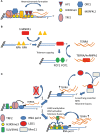Telomeric repeat-containing RNA TERRA: a noncoding RNA connecting telomere biology to genome integrity
- PMID: 25926849
- PMCID: PMC4396414
- DOI: 10.3389/fgene.2015.00143
Telomeric repeat-containing RNA TERRA: a noncoding RNA connecting telomere biology to genome integrity
Abstract
Telomeres are dynamic nucleoprotein structures that protect the ends of chromosomes from degradation and activation of DNA damage response. For this reason, telomeres are essential to genome integrity. Chromosome ends are enriched in heterochromatic marks and proper organization of telomeric chromatin is important to telomere stability. Despite their heterochromatic state, telomeres are transcribed giving rise to long noncoding RNAs (lncRNA) called TERRA (telomeric repeat-containing RNA). TERRA molecules play critical roles in telomere biology, including regulation of telomerase activity and heterochromatin formation at chromosome ends. Emerging evidence indicate that TERRA transcripts form DNA-RNA hybrids at chromosome ends which can promote homologous recombination among telomeres, delaying cellular senescence and sustaining genome instability. Intriguingly, TERRA RNA-telomeric DNA hybrids are involved in telomere length homeostasis of telomerase-negative cancer cells. Furthermore, TERRA transcripts play a role in the DNA damage response (DDR) triggered by dysfunctional telomeres. We discuss here recent developments on TERRA's role in telomere biology and genome integrity, and its implication in cancer.
Keywords: DNA damage response; R-loops; TERRA; cancer; genome integrity; telomerase; telomere.
Figures


Similar articles
-
Telomeric noncoding RNA: telomeric repeat-containing RNA in telomere biology.Wiley Interdiscip Rev RNA. 2014 May-Jun;5(3):407-19. doi: 10.1002/wrna.1220. Epub 2014 Feb 12. Wiley Interdiscip Rev RNA. 2014. PMID: 24523222 Review.
-
The Emerging Roles of TERRA in Telomere Maintenance and Genome Stability.Cells. 2019 Mar 15;8(3):246. doi: 10.3390/cells8030246. Cells. 2019. PMID: 30875900 Free PMC article. Review.
-
TERRA and Telomere Maintenance in the Yeast Saccharomyces cerevisiae.Genes (Basel). 2023 Feb 28;14(3):618. doi: 10.3390/genes14030618. Genes (Basel). 2023. PMID: 36980890 Free PMC article. Review.
-
Live-cell imaging reveals the dynamics and function of single-telomere TERRA molecules in cancer cells.RNA Biol. 2018;15(6):787-796. doi: 10.1080/15476286.2018.1456300. Epub 2018 Apr 16. RNA Biol. 2018. PMID: 29658398 Free PMC article.
-
The THO complex counteracts TERRA R-loop-mediated telomere fragility in telomerase+ cells and telomeric recombination in ALT+ cells.Nucleic Acids Res. 2023 Jul 21;51(13):6702-6722. doi: 10.1093/nar/gkad448. Nucleic Acids Res. 2023. PMID: 37246640 Free PMC article.
Cited by
-
TbTRF suppresses the TERRA level and regulates the cell cycle-dependent TERRA foci number with a TERRA binding activity in its C-terminal Myb domain.Nucleic Acids Res. 2021 Jun 4;49(10):5637-5653. doi: 10.1093/nar/gkab401. Nucleic Acids Res. 2021. PMID: 34048580 Free PMC article.
-
Molecular Genetic Studies of Pancreatic Neuroendocrine Tumors: New Therapeutic Approaches.Endocrinol Metab Clin North Am. 2018 Sep;47(3):525-548. doi: 10.1016/j.ecl.2018.04.007. Endocrinol Metab Clin North Am. 2018. PMID: 30098714 Free PMC article. Review.
-
Long Non-Coding RNAs in Neuronal Aging.Noncoding RNA. 2018 Apr 18;4(2):12. doi: 10.3390/ncrna4020012. Noncoding RNA. 2018. PMID: 29670042 Free PMC article. Review.
-
DNA Replication Origins and Fork Progression at Mammalian Telomeres.Genes (Basel). 2017 Mar 28;8(4):112. doi: 10.3390/genes8040112. Genes (Basel). 2017. PMID: 28350373 Free PMC article. Review.
-
Mitochondria in the spotlight of aging and idiopathic pulmonary fibrosis.J Clin Invest. 2017 Feb 1;127(2):405-414. doi: 10.1172/JCI87440. Epub 2017 Feb 1. J Clin Invest. 2017. PMID: 28145905 Free PMC article. Review.
References
Publication types
LinkOut - more resources
Full Text Sources
Other Literature Sources

